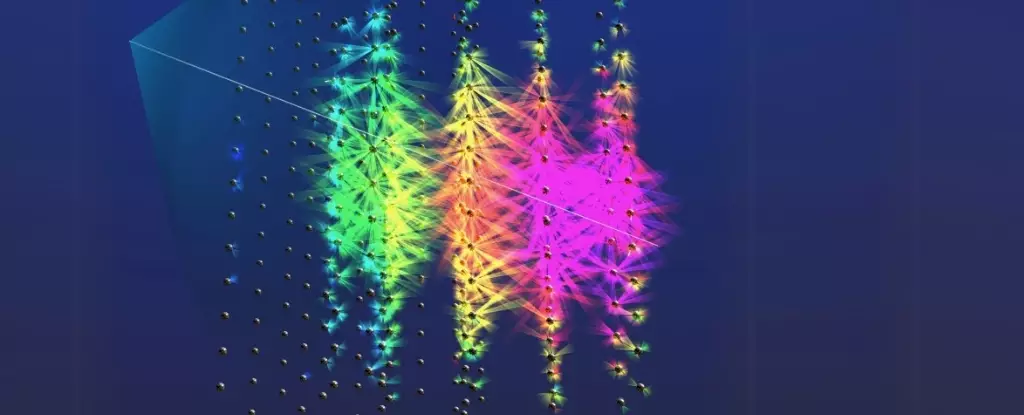Neutrinos, the ghostly particles that permeate our universe, have long fascinated both amateur astronomers and professional physicists alike. They are produced in incredible numbers by various cosmic phenomena but interact so infrequently with matter that detecting them poses a significant challenge. In recent developments, however, scientists have made a groundbreaking discovery that could reshape our understanding of high-energy astrophysics. On February 13, 2023, a neutrino was observed with unparalleled energy levels by an advanced undersea detector off the coast of Sicily, sparking intrigue about its origins and implications.
The neutrino detected during this cosmic episode was measured to have an extraordinary energy level of 220 petaelectronvolts (PeV). For context, this figure dwarfs the previous record of 10 PeV. The sheer magnitude of this detection raises intriguing questions about the astronomical phenomena capable of generating such immense energy. Historically, only a select group of cosmic entities has been known to accelerate particles to these extreme levels; supernovae and black holes serve as prime examples. Yet, with this recent finding, scientists are nudging closer to understanding enigmatic sources like blazars—supermassive black holes emitting jets of radiation directed toward Earth.
The detection process employed at the depths of the Mediterranean Sea utilized the Cubic Kilometer Neutrino Telescope (KM3NeT). Positioned 3,450 meters beneath the surface, this facility comprises numerous modules equipped with light-sensitive detectors designed to capture the fleeting signs of neutrinos interacting with medium such as water. In the event of the detected neutrino, over 28,000 photons were recorded, which stemmed from a cascade of interactions initiated by the high-energy particle. The light emissions were primarily due to the production of a muon, another elementary particle generated during this interaction, which itself carried approximately 120 PeV of energy.
This exceptional effort demonstrates the monumental scale of technology and collaboration necessary for probing the challenging world of neutrino detection. With thousands of light detectors constantly monitoring the surrounding water for even the faintest signal, researchers endeavor to peel back the layers of the universe’s vibrant tapestry.
A compelling characteristic of neutrinos is their ability to traverse vast cosmic distances largely unimpeded by matter. This quality complicates the task of pinpointing their origins. Following the detection of the neutrino, researchers embarked on a mission to explore potential sources emanating from its trajectory. The investigation comprised four key hypotheses: potentially originating from our galaxy, from nearby extragalactic regions, from transient events like gamma-ray bursts, or originating from far-off galaxies.
As researchers delved into the possibilities, they found that none fit perfectly with the first three categories. The emergent focus shifted toward extragalactic origins, with active supermassive black holes emerging as the likely suspects. The researchers screened the identified region in multiple wavelength ranges to establish connections with known blazars, leading to the identification of 12 candidates. However, they caution that further investigations are paramount, as the vastness of space and the multitude of blazars dilute the likelihood of any singular association.
Another intriguing hypothesis arises from the potential for this neutrino to be a cosmogenic particle. This concept refers to high-energy neutrinos produced through interactions between cosmic rays and the cosmic microwave background radiation—the remnant glow of the Big Bang. If substantiated, this would mark a historical milestone as the initial identification of a neutrino generated through this cosmic mechanism.
As the scientific community delves deeper into the sprawling enigma of high-energy neutrinos, this detection serves as an impetus for future exploration. Scientists grapple with questions not only regarding the specific origin of this particle but also its broader implications for our understanding of the universe’s most energetic phenomena.
The observation of this record-breaking neutrino offers a launching pad for new inquiries into the cosmos. It underscores the intricacies of high-energy astrophysics and enhances our grasp of the grander narrative of particle physics. Researchers remain steadfast in their commitment to unraveling the mysteries surrounding neutrinos, promising future revelations that could help bridge gaps in our knowledge of cosmic events.
The quest for understanding the origins of high-energy neutrinos is ongoing, representing both a challenge and an opportunity for scientists. As the tools and technologies for detection advance, the cosmos may soon yield even more secrets, bringing us closer to answering some of the most pressing questions about our universe. Forthcoming research will be integral in either confirming or dispelling the theories surrounding this remarkable neutrino, heralding a new era in astrophysics as we continue to explore the unfathomable depths of space.

